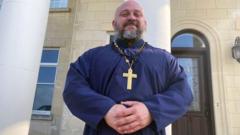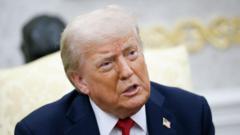Over the past 18 months, a surge of young American men has converted to Russian Orthodoxy, drawn by its promise of traditional masculinity and family values. Contributing factors include disillusionment with contemporary societal norms and the desire for a unifying community anchored in traditional beliefs.
The Rise of Russian Orthodoxy Among Young American Men Seeking Traditional Masculinity

The Rise of Russian Orthodoxy Among Young American Men Seeking Traditional Masculinity
A notable trend sees a growing number of young American men converting to Russian Orthodox Christianity, driven by a desire for traditional values and virile masculinity.
In recent months, a striking trend has emerged among young American men who are seeking a deeper connection to tradition and masculinity by converting to Russian Orthodox Christianity. This movement, exemplified in a Georgetown, Texas parish led by Father Moses McPherson, has seen congregational growth triple within a year and a half, culminating in a community that resonates strongly with contemporary masculinity issues.
Father Moses, a charismatic figure who crafts a unique brand of virile masculinity, regularly engages with followers through social media. His messages poke fun at modern masculinity, dismissing attributes such as skinny jeans and eyebrow grooming as too feminine. Rather, his online presence—a blend of heavy metal workouts and theological discussions—strikes a chord with young men who feel increasingly marginalized by modern societal expectations.
Men like Theodore, a recent convert, recount feeling empty despite personal success, attributing their discontent to societal pressures that portray traditional roles as toxic. Many converts express that this newfound faith offers a sense of belonging and purpose, aligning with their views on family and masculinity which they believe are under attack in contemporary America.
Home-schooling has become a common practice among these families, seen as a way to maintain religious educational standards and shield children from perceived cultural shifts that contradict their values. Figures like Archpriest John Whiteford assert that teaching children in a religious context also serves to protect them from discussions on topics like "transgenderism."
Despite the small percentage of Orthodox Christians in America—about one percent—the rise in male converts is evidently significant, as research indicates a marked trend towards male representation within the faith. This increased engagement follows the pandemic, which prompted many to reflect on their life choices and spiritual paths.
In a twist of irony, this influx of traditional masculinity advocates has been associated with changing political landscapes, notably in light of past U.S. administrations. Many younger followers view the Russian Orthodox Church as an antidote to increasingly "feminized" Western worship styles, describing services that they feel align more closely with their values as being "real."
Critics, however, point out that some among the new converts approach Orthodoxy with an overly simplistic or militaristic mindset. Yet they find solace in ideals presented by lead figures within the faith, who criticize consumerism and promote family loyalty as guiding principles.
As converts like Buck Johnson navigate their newfound beliefs, they often confront broader geopolitical views shaped by longstanding tensions. Their understanding of Russia is increasingly shaped by a desire for authenticity in faith and a communal structure that stands in stark contrast to their experiences in American culture.
In conclusion, the upsurge in conversions to Russian Orthodoxy among young men reflects a collective yearning for purpose and an embrace of traditional values in an era where they often feel disconnected and criticized. As this trend continues to evolve, it may very well reshape local communities and contribute to broader discussions around modern masculinity and faith-driven identity.
Father Moses, a charismatic figure who crafts a unique brand of virile masculinity, regularly engages with followers through social media. His messages poke fun at modern masculinity, dismissing attributes such as skinny jeans and eyebrow grooming as too feminine. Rather, his online presence—a blend of heavy metal workouts and theological discussions—strikes a chord with young men who feel increasingly marginalized by modern societal expectations.
Men like Theodore, a recent convert, recount feeling empty despite personal success, attributing their discontent to societal pressures that portray traditional roles as toxic. Many converts express that this newfound faith offers a sense of belonging and purpose, aligning with their views on family and masculinity which they believe are under attack in contemporary America.
Home-schooling has become a common practice among these families, seen as a way to maintain religious educational standards and shield children from perceived cultural shifts that contradict their values. Figures like Archpriest John Whiteford assert that teaching children in a religious context also serves to protect them from discussions on topics like "transgenderism."
Despite the small percentage of Orthodox Christians in America—about one percent—the rise in male converts is evidently significant, as research indicates a marked trend towards male representation within the faith. This increased engagement follows the pandemic, which prompted many to reflect on their life choices and spiritual paths.
In a twist of irony, this influx of traditional masculinity advocates has been associated with changing political landscapes, notably in light of past U.S. administrations. Many younger followers view the Russian Orthodox Church as an antidote to increasingly "feminized" Western worship styles, describing services that they feel align more closely with their values as being "real."
Critics, however, point out that some among the new converts approach Orthodoxy with an overly simplistic or militaristic mindset. Yet they find solace in ideals presented by lead figures within the faith, who criticize consumerism and promote family loyalty as guiding principles.
As converts like Buck Johnson navigate their newfound beliefs, they often confront broader geopolitical views shaped by longstanding tensions. Their understanding of Russia is increasingly shaped by a desire for authenticity in faith and a communal structure that stands in stark contrast to their experiences in American culture.
In conclusion, the upsurge in conversions to Russian Orthodoxy among young men reflects a collective yearning for purpose and an embrace of traditional values in an era where they often feel disconnected and criticized. As this trend continues to evolve, it may very well reshape local communities and contribute to broader discussions around modern masculinity and faith-driven identity.





















